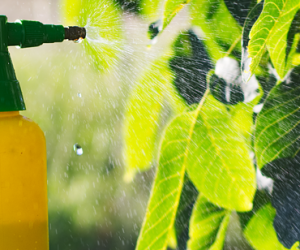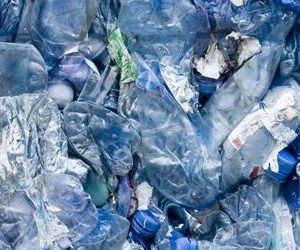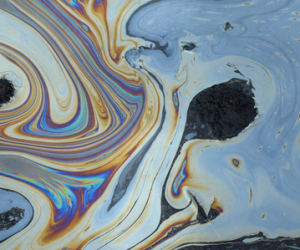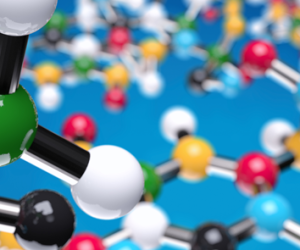Chemical Contaminants
Chemical contaminants are chemicals present in soil, air and water that are harmful to plants and animals. Though some may occur naturally, the majority of chemical contaminants enter the environment through industrial activities, discharge from wasterwater treatment facilities, manufacturing and usage of consumer products and agricultural activities.
Contaminants that are in our environment today can be classed into three categories; legacy contaminants, contaminants that are known to be problematic but are still in use today, and contaminants that are an emerging concern. A number of these pollutants have been observed, or are potentially present, in the Lake Simcoe watershed.

A pesticide is a substance used for preventing, destroying, repelling, or mitigating biological pests. Pesticides have provided incredible advantages in many ways by increasing crop yields and bolstering food availability. Unfortunately, their use can have unintended negative impacts. Contemporary pesticides are those that are currently used or have recently come under restriction in Ontario.

Flame retardants are chemicals that can be applied to an object to make it resistant to catching fire. They are used industrially and can also be found on manufactured items such as couches, electronics and even baby toys. The chemical structures of flame retardants make them persistent (long-lasting) in the environment.

Microplastics are small but potentially harmful plastic pieces that can have negative impacts on rivers, lakes, oceans, fish and other wildlife. Researchers are working to understand the extent of pollution and risks, including predictions of future microplastic abundance for both aquatic (water) and terrestrial (land) ecosystems.

Perfluoroalkyl substances (PFASs) are commonly found in everyday products like non-stick frying pans and sprays used to provide stain resistance. They are also used in fire-fighting foam and in industries such as aerospace. PFASs are very persistent in the environment and in the human body – meaning they don’t break down and they can accumulate over time.

Petroleum hydrobcarbons are commonly known as fossil fuels. They are found in essential everyday life products such as gasoline for cars and jet fuel. They are also used in creating materials like plastic, computers and MRI scanners. Contamination from PHCs is one of the most common types of soil and groundwater pollution in Canada.

We use pharmaceuticals and personal care products every day. These common items include medications (both over the counter and prescription drugs), as well as soaps, detergents, cosmetics, perfumes and deodorants. These products provide us with many health benefits. However, there are growing concerns around their presence in our environment.

Phenols are used in the construction, automotive and appliance industries and are commonly found in household cleaners as disinfectants. Phenols do not tend to persist or accumulate in the environment. They are most dangerous and concerning when found in large quantities (such as from industrial spills).

Polychlorinated naphthalenes were once used for cable insulation and preservation of wood, paper and textile products. PCNs have been phased out of use, but can be produced naturally as a by-product in combustion or emitted during metal refinement. Despite being largely phased out, their persistence in the environment continues.
Lake Simcoe and its Tributaries
In fall 2023 and spring 2024, studies were undertaken to investigate levels of chemical contaminants in the surface water and sediments of Lake Simcoe and its tributaries. The contaminants included in this study were chosen based on five criteria: 1) historical use within the watershed; 2) previous research undertaken (such as the previous LSRCA 2004 and 2015 studies); 3) literature from similar areas in the Great Lakes Region; and 4) analysis capabilities of commercial laboratories.
Seven contaminants were chosen: 1) organochlorine pesticides (OCPs), including DDT and its metabolites; 2) polychlorinated biphenyls (PCBs); 3) petroleum hydrocarbons (PHCs) and benzene, toluene, ethylbenzene, and xylene (BTEX); 4) semi-volatile organic compounds (SVOCs), including polycyclic aromatic hydrocarbons (PAHs); 5) phenols; 6) per- and polyfluorinated substances (PFASs); and 7) metals.
Generally, the contaminants recorded in the Lake Simcoe Watershed are the result of non-point anthropogenic sources (e.g., fossil fuel combustion) and specific areas of industrial, urban, and agricultural land-use activities (e.g., pesticides). Although some contaminants may be linked to current uses (e.g., PHCs, PAHs), others are likely legacy contaminants (e.g., OCPs) from historical activities.
Throughout the watershed, tributary waters contain fewer contaminants than their underlying sediments. Concentrations of contaminants in tributary waters were predominately lower in the spring than in the fall, presumably due to dilution associated with heavier flows. PCBs, BTEX, phenols, and PFAS were not detected at any tributary sites. Concentrations of heavy metals in urban tributaries and polder sites sometimes exceeded guidelines but fell below the Probable Effect Levels (PEL), meaning that the impact of these metals on biota is unclear. With one exception, polder sites tended to exhibit lower concentrations of PHC and PAH, but higher concentrations of OCP, than urban sites. Concentrations of DDD and DDE, derivates of DDT (a type of OCP), are high in the Holland Marsh, as has been reported in previous studies (LSRCA, 2020; Lembcke et al., 2011).
Analyses of contaminants from Lake Simcoe revealed elevated levels of PAHs and chromium in lake waters, and relatively high concentrations of PAHs and heavy metals in lake sediments compared to provincial and federal guidelines. Metal concentrations in lake sediments were particularly concerning, with heavy metals consistently exceeding the PEL in 2015, 2023, and 2024. Of note are cadmium levels in Kempenfelt Bay sediments, which were measured at 47x the PEL.
It is recommended that regular monitoring of specific contaminants (e.g. DDT and metabolites, cadmium, heavy metals) be undertaken more frequently, particularly in Lake Simcoe. Sampling should target areas of guideline exceedances such as urban centres (Aurora, Barrie, Newmarket), intensive agricultural areas (Holland Marsh and other polders), and Lake Simcoe (e.g., Kempenfelt Bay and Cook’s Bay).
![]() Who to Contact
Who to Contact
Integrated Watershed Management
✆ 905-895-1281
✆ 1-800-465-0437 Toll free 
![]() New Report
New Report
Chemical Contaminants in Lake Simcoe and its Tributaries
In 2024, a study was undertaken to investigate levels of chemical contaminants in the surface water and sediments of Lake Simcoe and its tributaries. The contaminants included in this study were chosen based on historical use within the watershed, previous research, and literature from similar areas in the Great Lakes Region. This study investigated the following contaminants: 1) petroleum hydrocarbons (or PHCs) and benzene, toluene, ethylbenzene, and xylene (BTEX); 2) semi-volatile organic compounds (SVOCs), including polycyclic aromatic hydrocarbons (PAHs); 3) phenols; 4) metals, including chromium and mercury; 5) organochlorine pesticides (OCPs), including DDT and its metabolites; 6) polychlorinated biphenyls (PCBs); and 7) per- and poly-fluorinated substances (PFASs).
Read Chemical Contaminants in Lake Simcoe and its Tributaries
